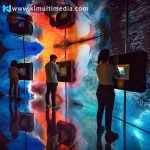Art has always evolved with technology—from cave paintings to oil canvases to photography. Today, digital graphics are enabling a new wave of immersive, interactive, and dynamic art installations that engage the senses in ways never seen before. These aren’t just pictures on a screen; they are experiences, often built in physical spaces using computer-generated visuals projected onto walls, objects, or even air.
Whether it’s an entire room responding to the movement of a viewer, a light sculpture reacting to real-time sound, or a digital forest blooming with each step, these visual art installations powered by computer graphics redefine the boundaries between the virtual and the physical.
Digital art installations are large-scale artworks that use computer-generated graphics as a core element. Unlike traditional art, these installations are often interactive, multi-sensory, and site-specific, requiring space and active audience participation.
These works may incorporate:
Have you ever experienced a digital or interactive art installation in person?
Do you think digital graphics in art reduce its emotional value or enhance it?
Would you ever create digital art if given the tools?
Let us know what you think in the comments!
Whether it’s an entire room responding to the movement of a viewer, a light sculpture reacting to real-time sound, or a digital forest blooming with each step, these visual art installations powered by computer graphics redefine the boundaries between the virtual and the physical.
What Are Digital Art Installations?
Digital art installations are large-scale artworks that use computer-generated graphics as a core element. Unlike traditional art, these installations are often interactive, multi-sensory, and site-specific, requiring space and active audience participation.
These works may incorporate:
- Projected imagery using 3D graphics
- Augmented and virtual reality (AR/VR)
- Motion tracking and gesture-based interaction
- LED screens or touch-sensitive surfaces
- Audio-visual synchronization with music
The Role of Computer Graphics in Modern Installations
- Artists use 3D computer graphics to map visual content onto irregular surfaces (buildings, sculptures, etc.).
- Makes stationary objects appear alive or in motion
- Algorithms generate ever-changing visuals based on user input or data feeds.
- The outcome is different for every viewer or moment.
- Using mobile apps or AR glasses, computer-generated visuals are superimposed over the real environment, creating hybrid realities.
- Computer graphics respond to real-time stimuli like movement, voice, heat, or light.
- For example, a wall might bloom into flowers as you walk past it.
Notable Digital Graphics-Based Installations
- teamLab Borderless (Tokyo): A museum where computer graphics create an interactive universe of colors, motion, and sound.
- Refik Anadol’s Data Sculptures: Uses AI and large datasets (like weather or brainwave data) to create swirling digital visuals projected on walls or domes.
- Meow Wolf (USA): Blends story-based physical installations with immersive digital projections to create an entire fictional universe.
Benefits of Using Computer Graphics in Art
- Unlimited Creativity: Artists are not limited by physical media—only by imagination and software capability.
- Interactivity: Viewers can shape, trigger, or influence the visuals, making each visit unique.
- Scalability: Installations can be replicated or transformed for different spaces with ease.
- Sustainability: Many digital works require less material waste than traditional construction-based exhibits.
- Accessibility: Remote audiences can view or interact via online virtual installations or AR.
Tools and Software Used
- TouchDesigner & VVVV: For real-time visual rendering and interaction control.
- Unity and Unreal Engine: Common for AR/VR experiences and immersive graphics.
- Blender and Maya: 3D modeling and animation software.
- Arduino + Sensors: For connecting digital visuals to physical interactivity.
Challenges and Considerations
- High Cost of Setup: Projection systems, sensors, and computing hardware can be expensive.
- Maintenance and Bugs: Graphics software may need regular updates and debugging.
- Audience Accessibility: Not all audiences are comfortable interacting with digital tech.
- Overstimulation Risk: Too many visuals or sounds can overwhelm users instead of inspiring them.
- Preservation Issues: Unlike traditional paintings, digital installations are harder to preserve or archive.
Future of Graphics-Based Art Installations
- Metaverse Galleries: Artists may build fully virtual exhibitions within shared 3D worlds.
- AI-Curated Art: Installations that evolve based on audience mood, age, or cultural background.
- Biofeedback Integration: Installations that read heart rate or brainwaves to adapt visuals in real time.
- Holographic Display Art: Freestanding 3D graphics without the need for glasses or screens.
Join the Conversation
Have you ever experienced a digital or interactive art installation in person?
Do you think digital graphics in art reduce its emotional value or enhance it?
Would you ever create digital art if given the tools?
Let us know what you think in the comments!

